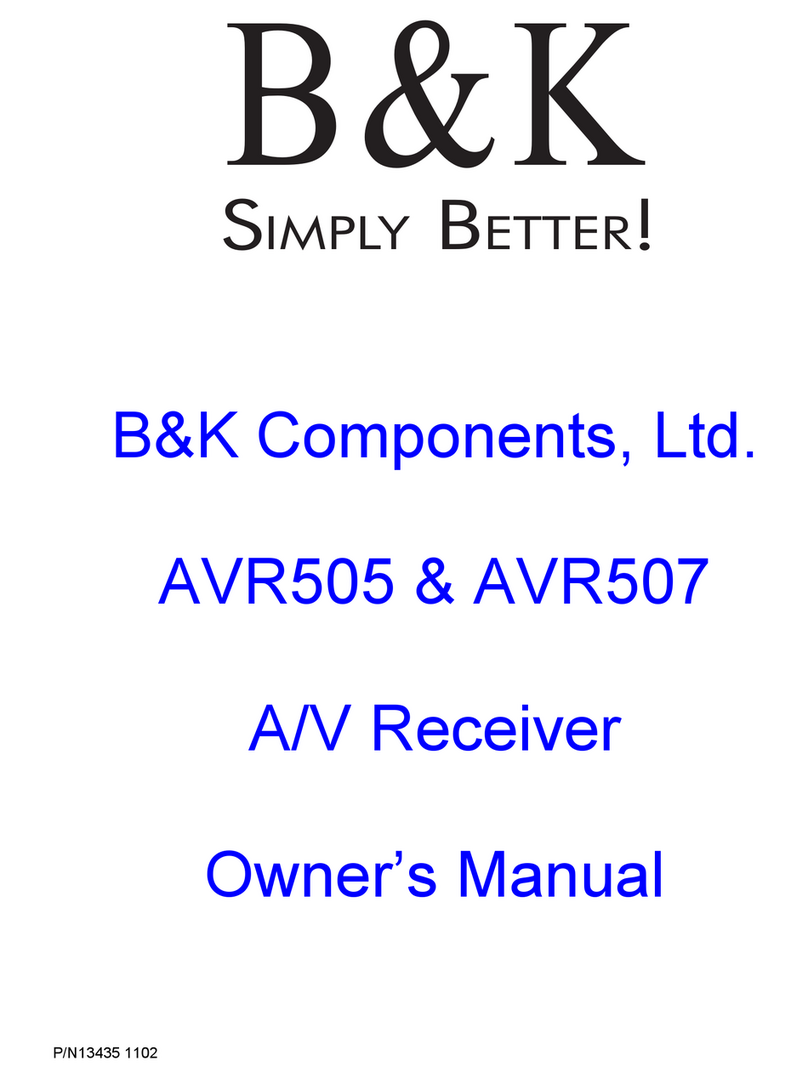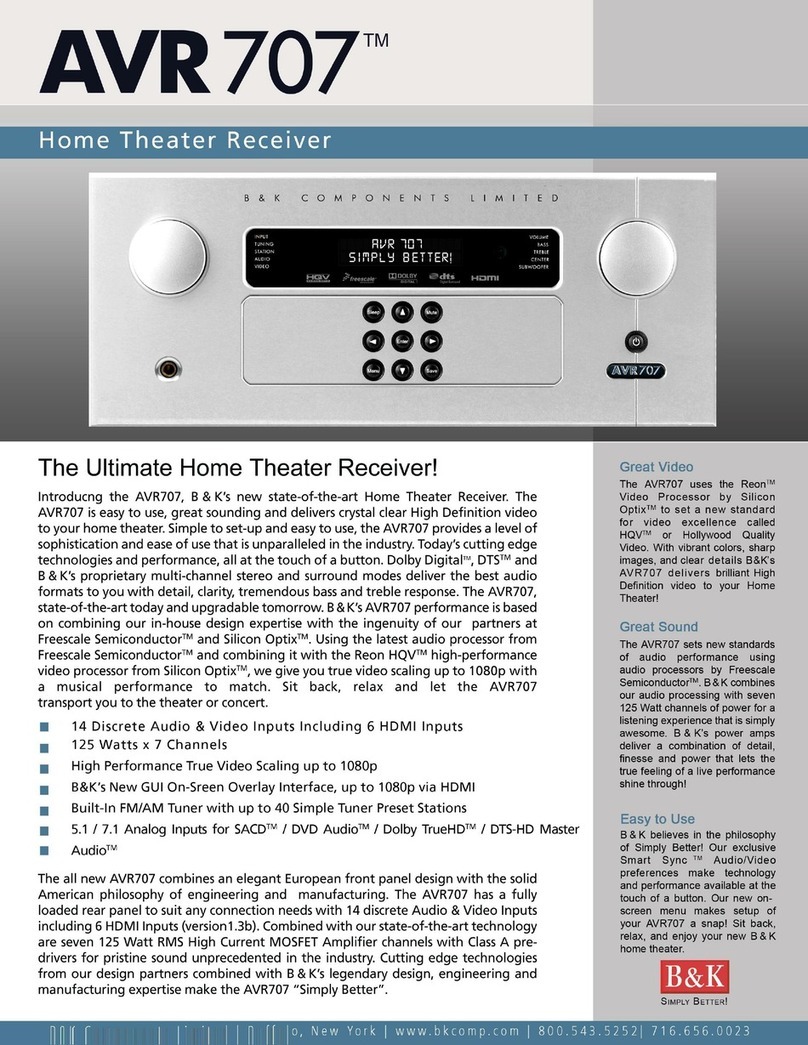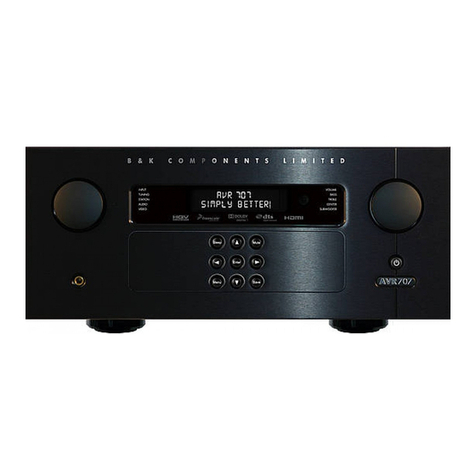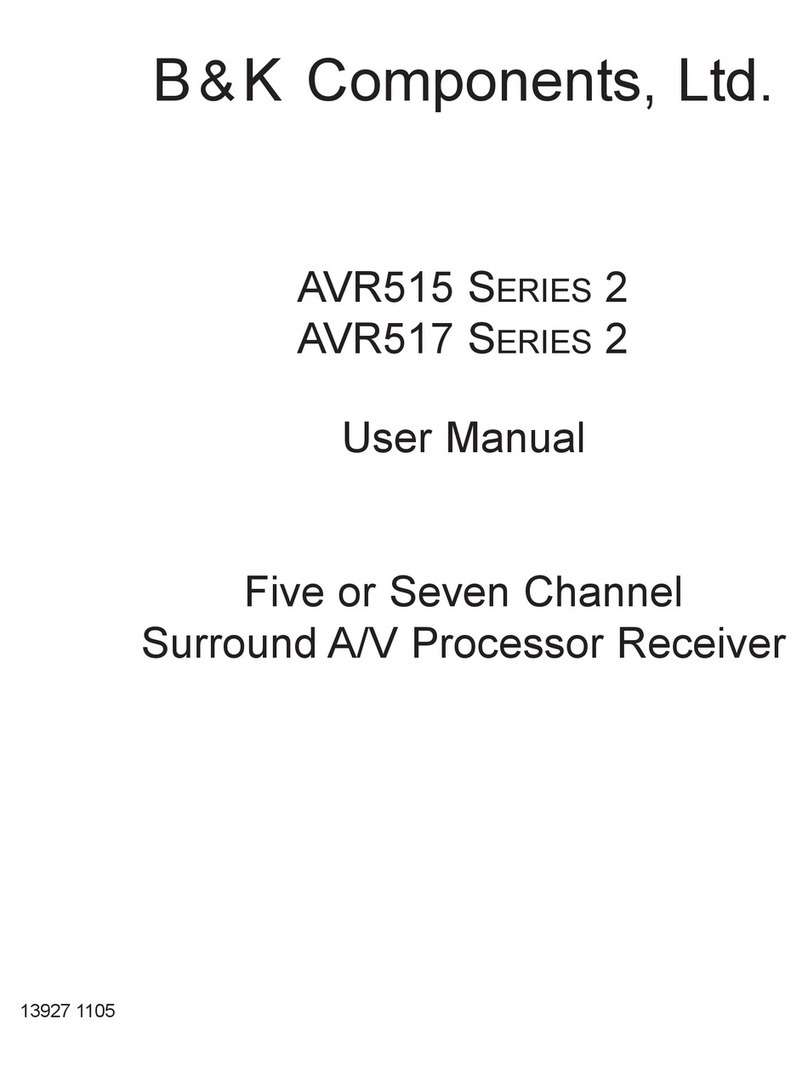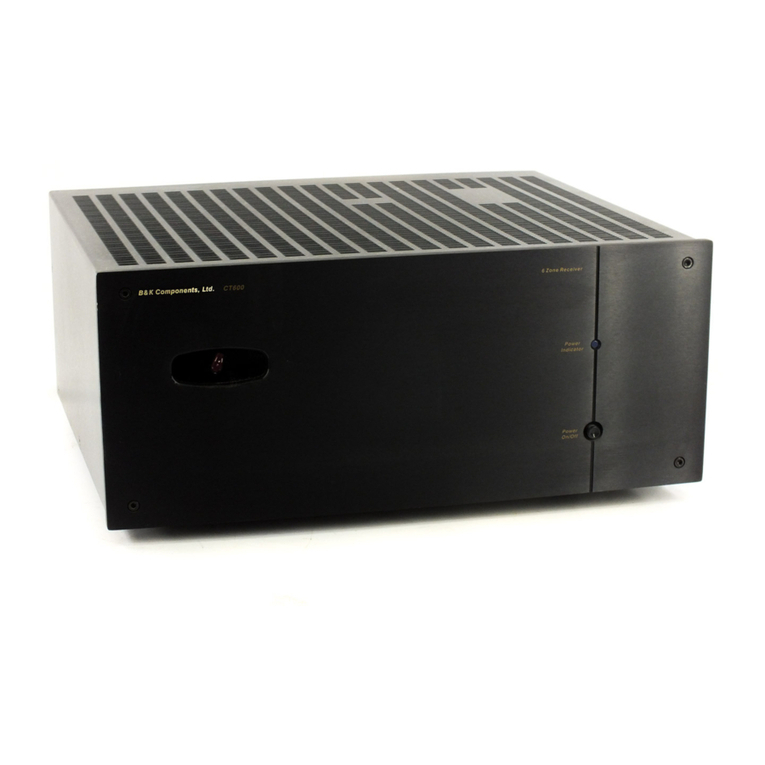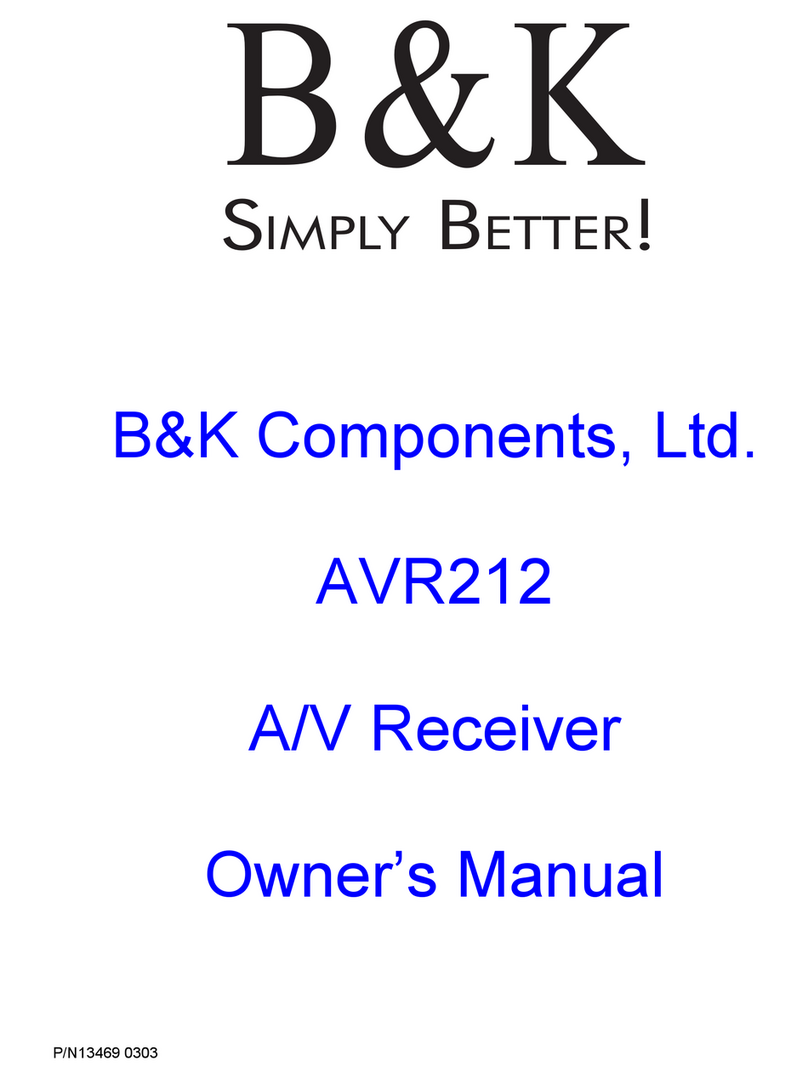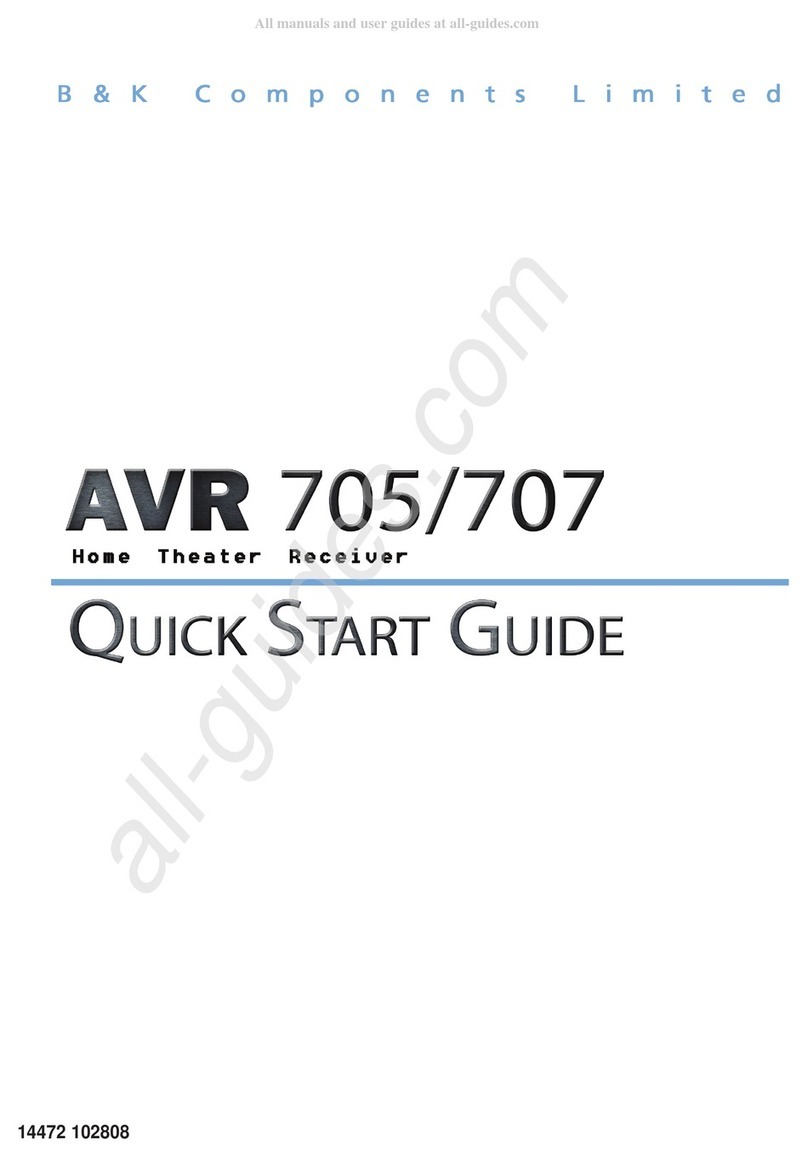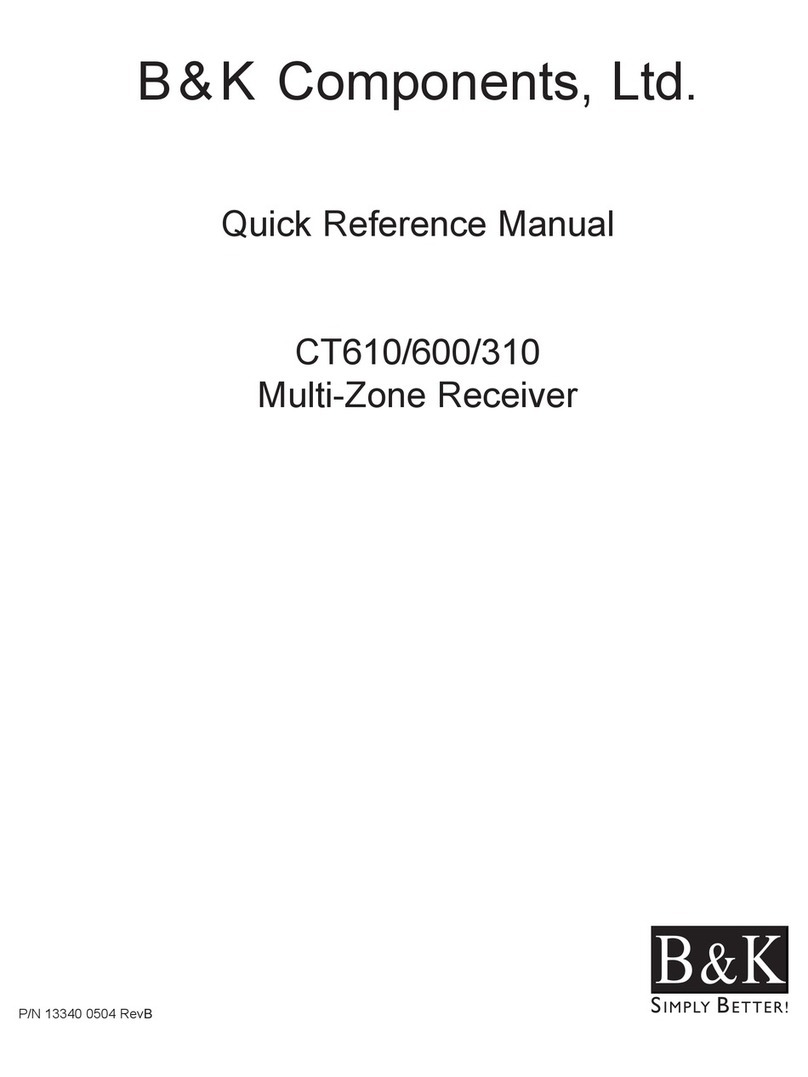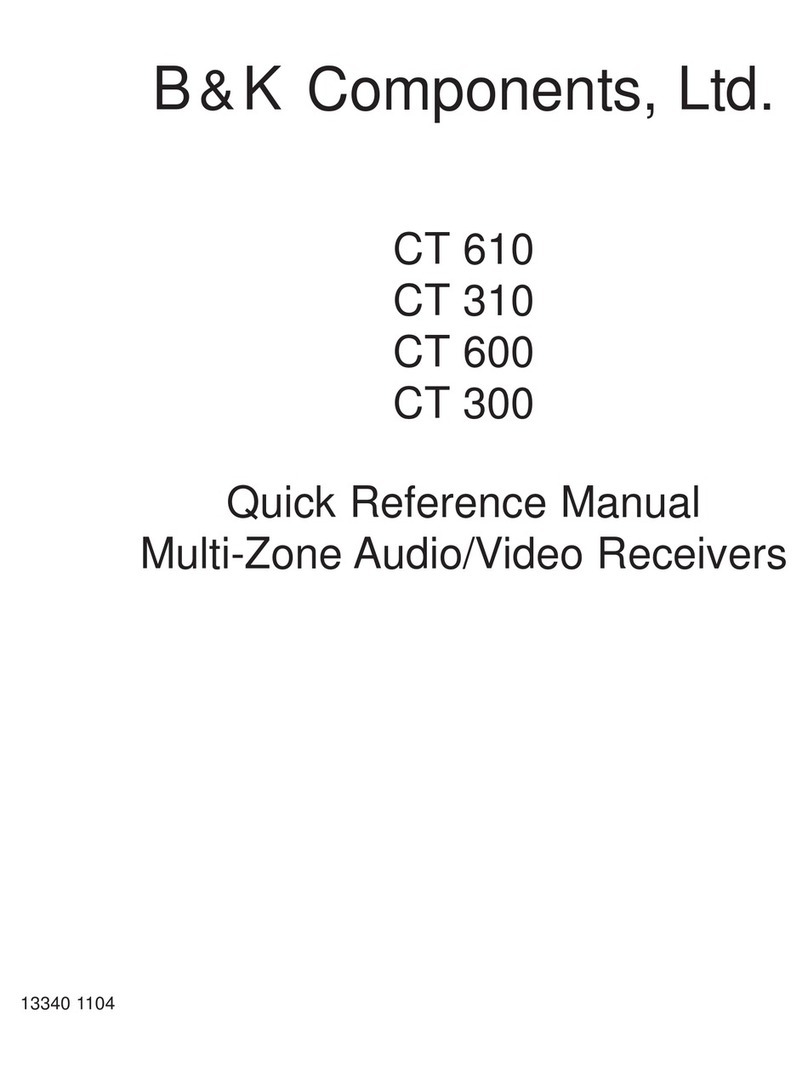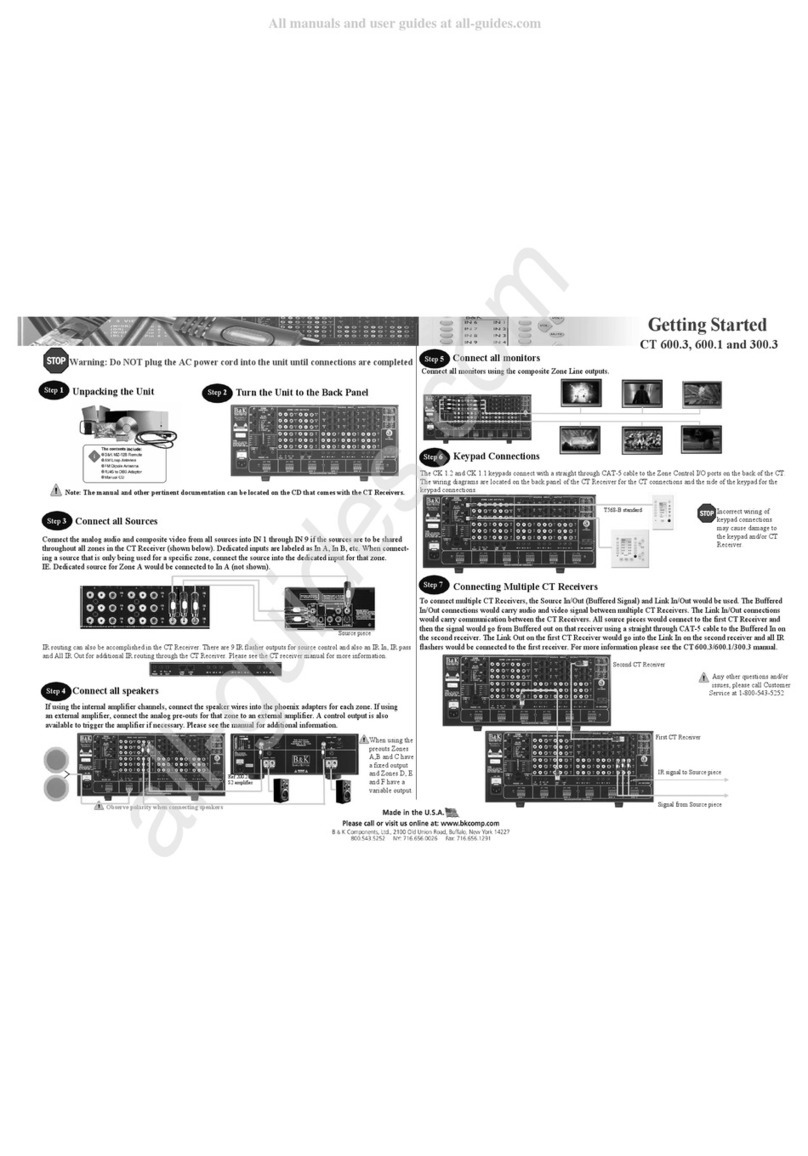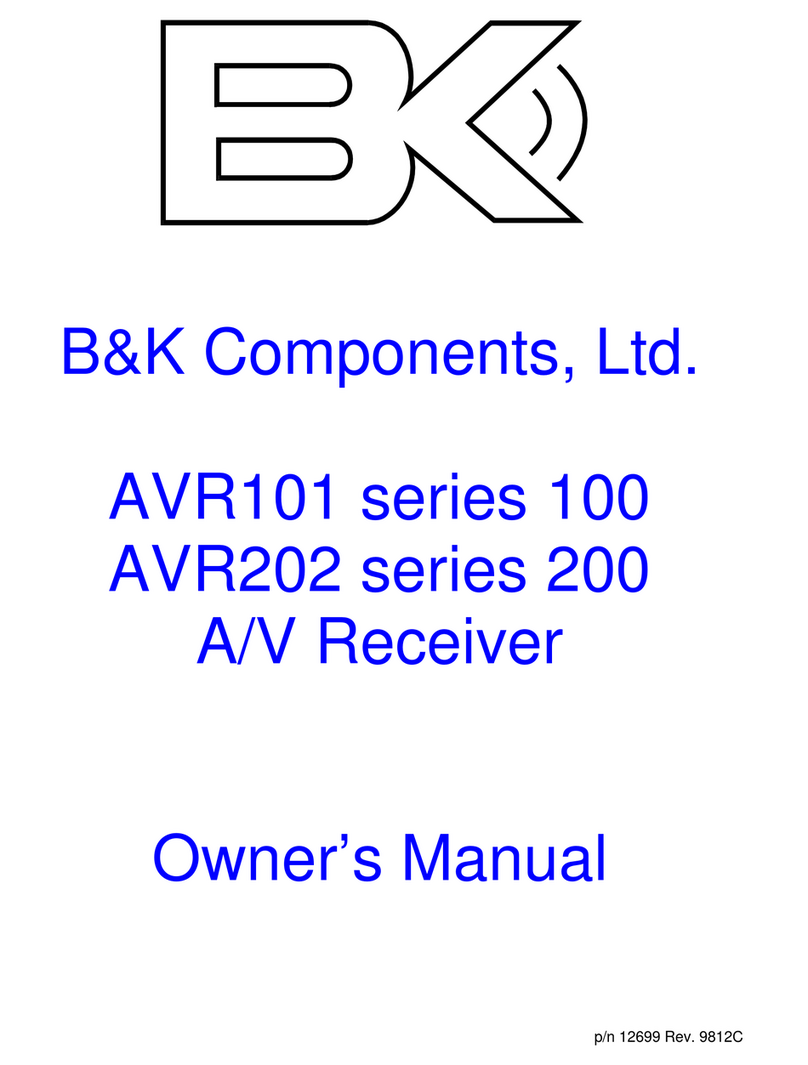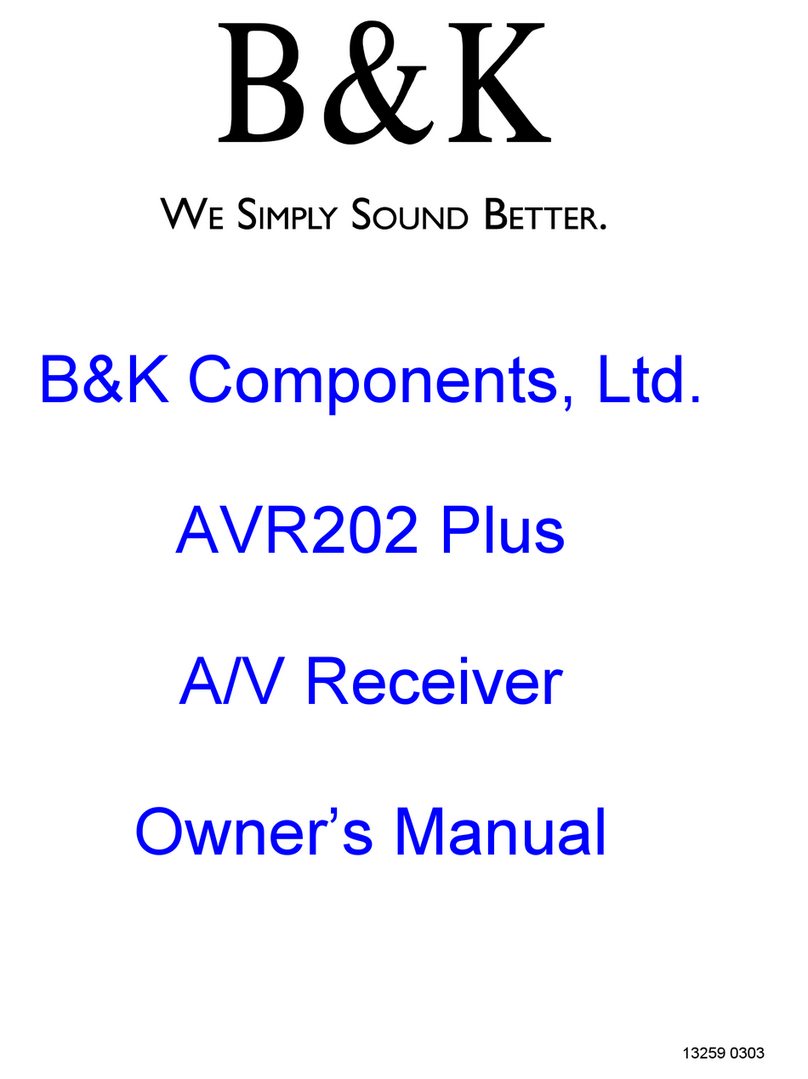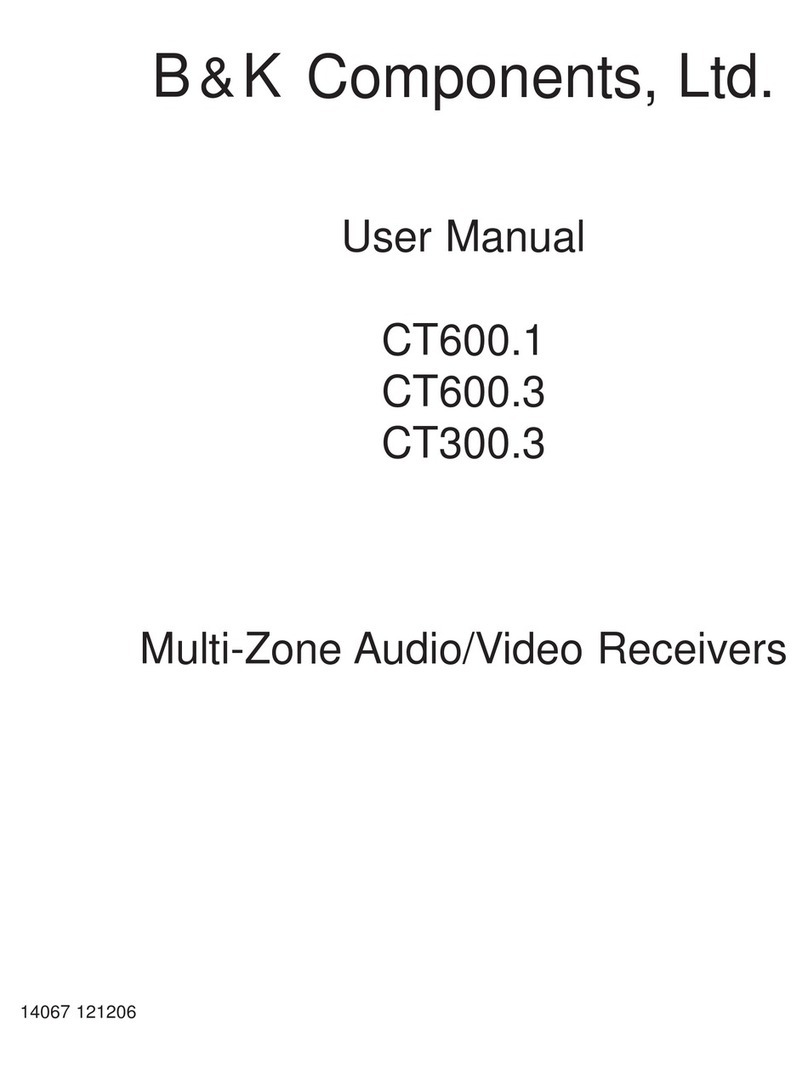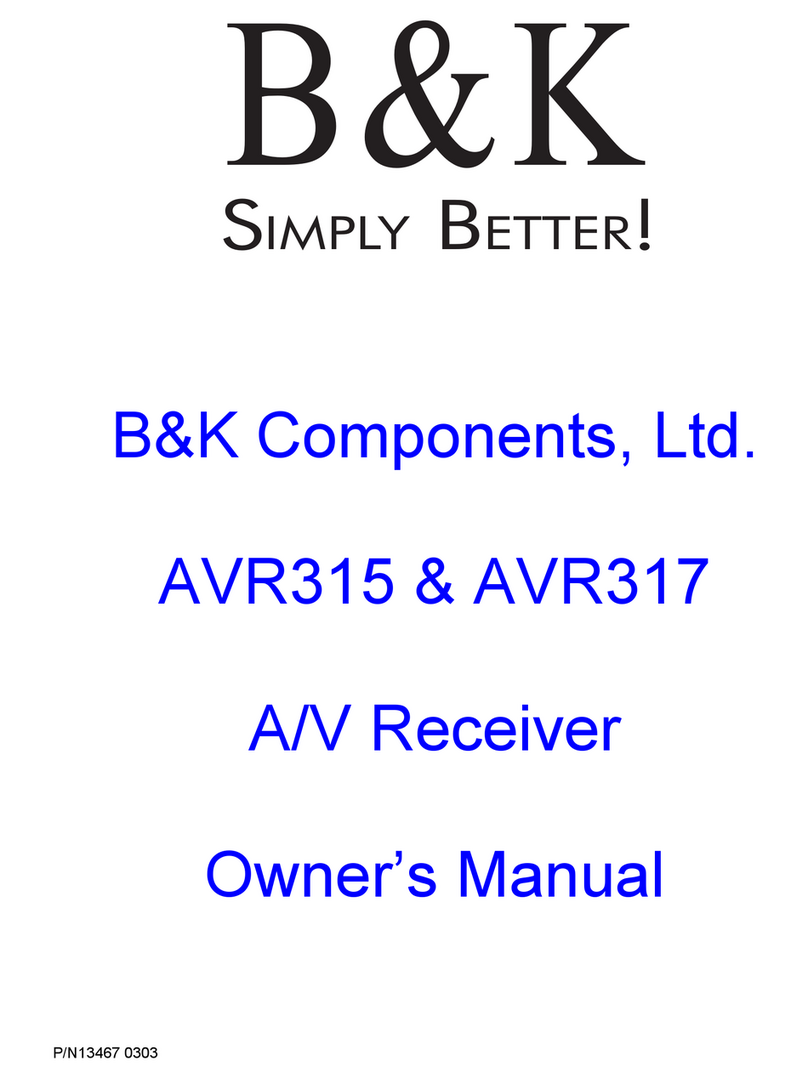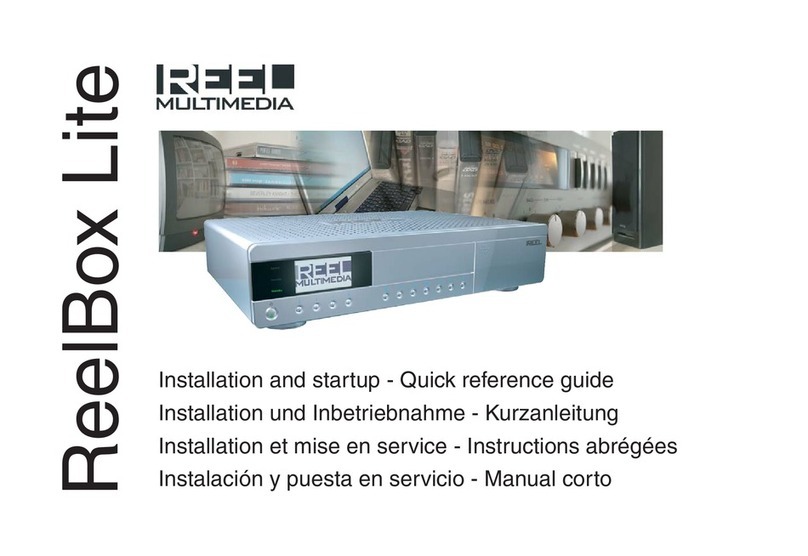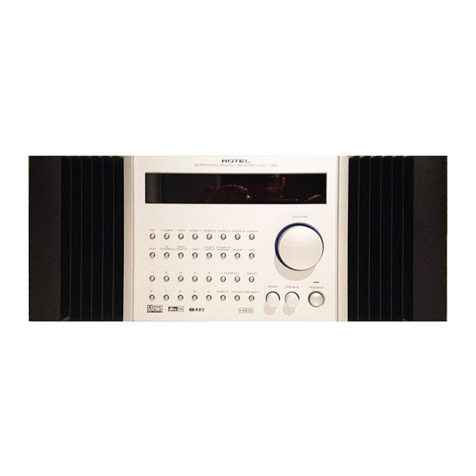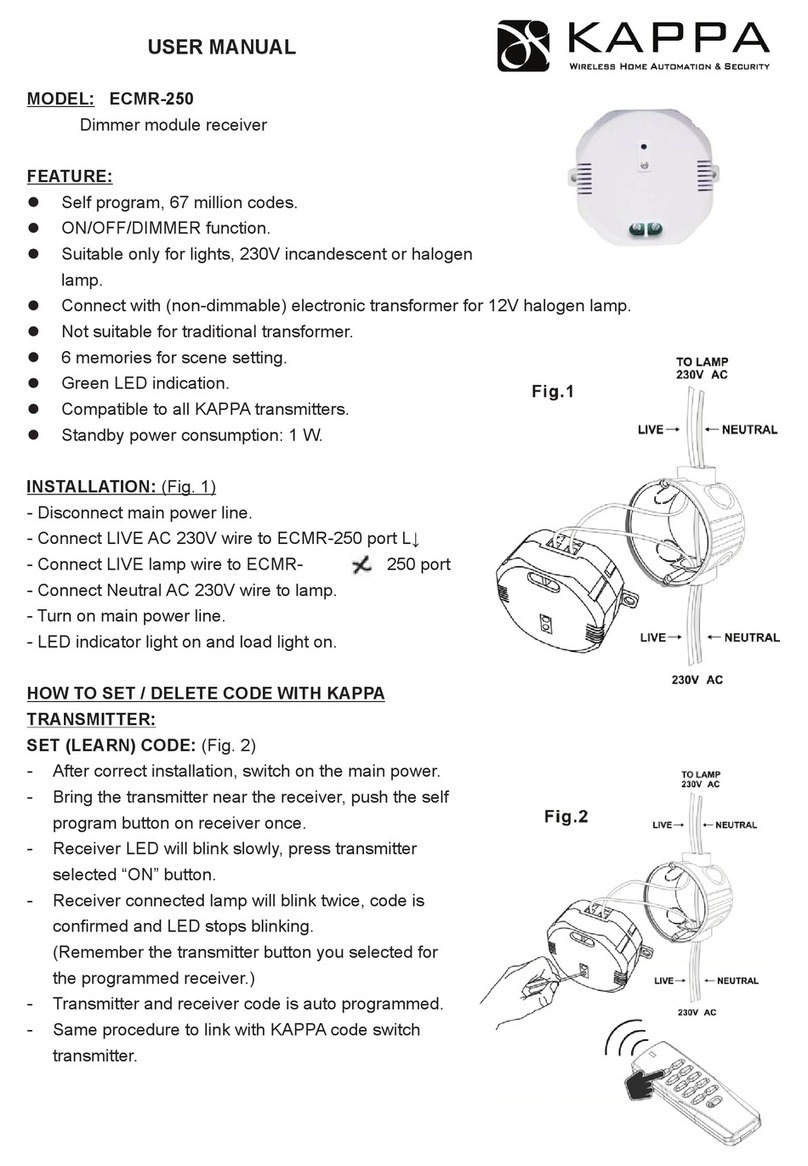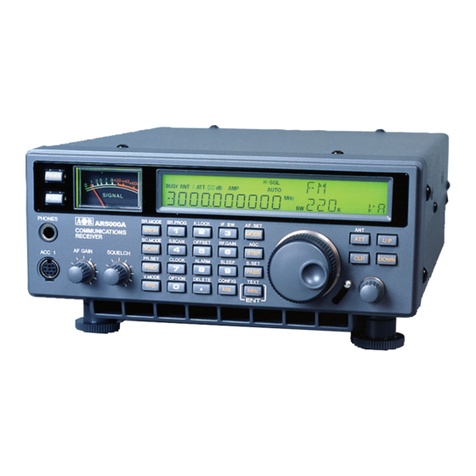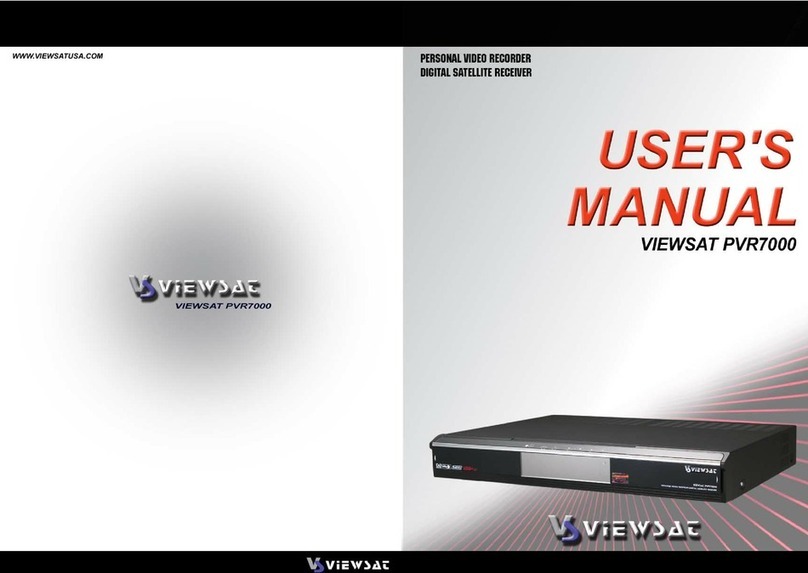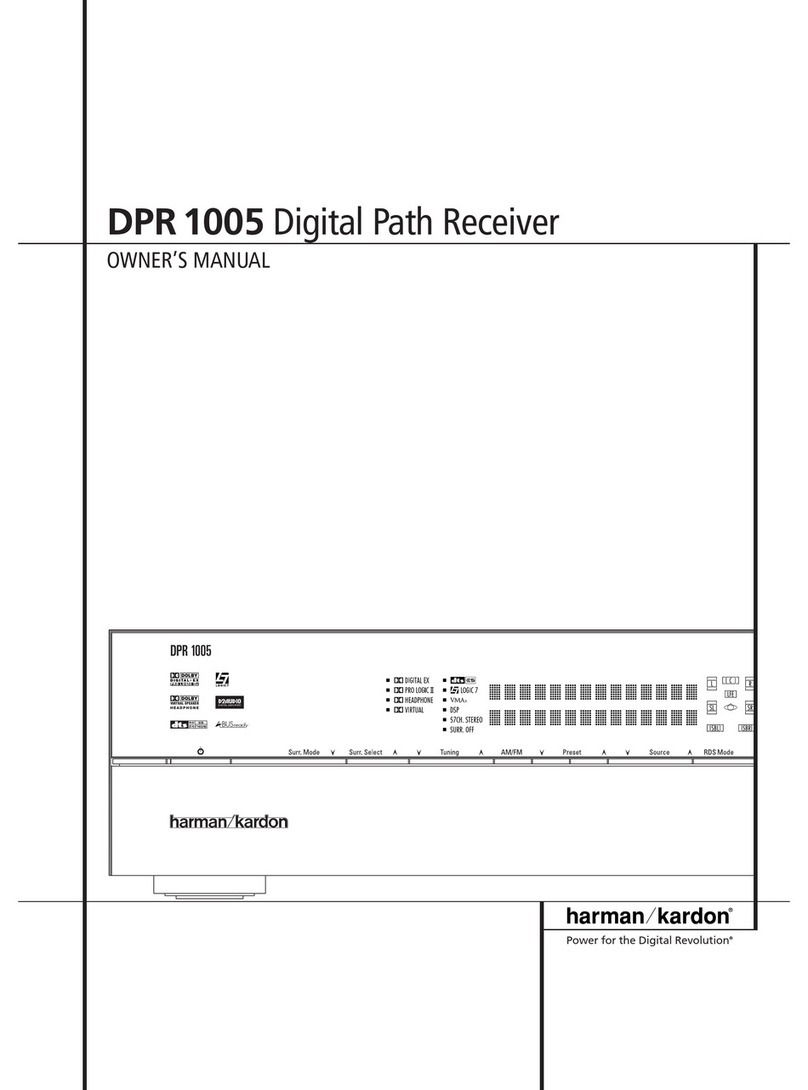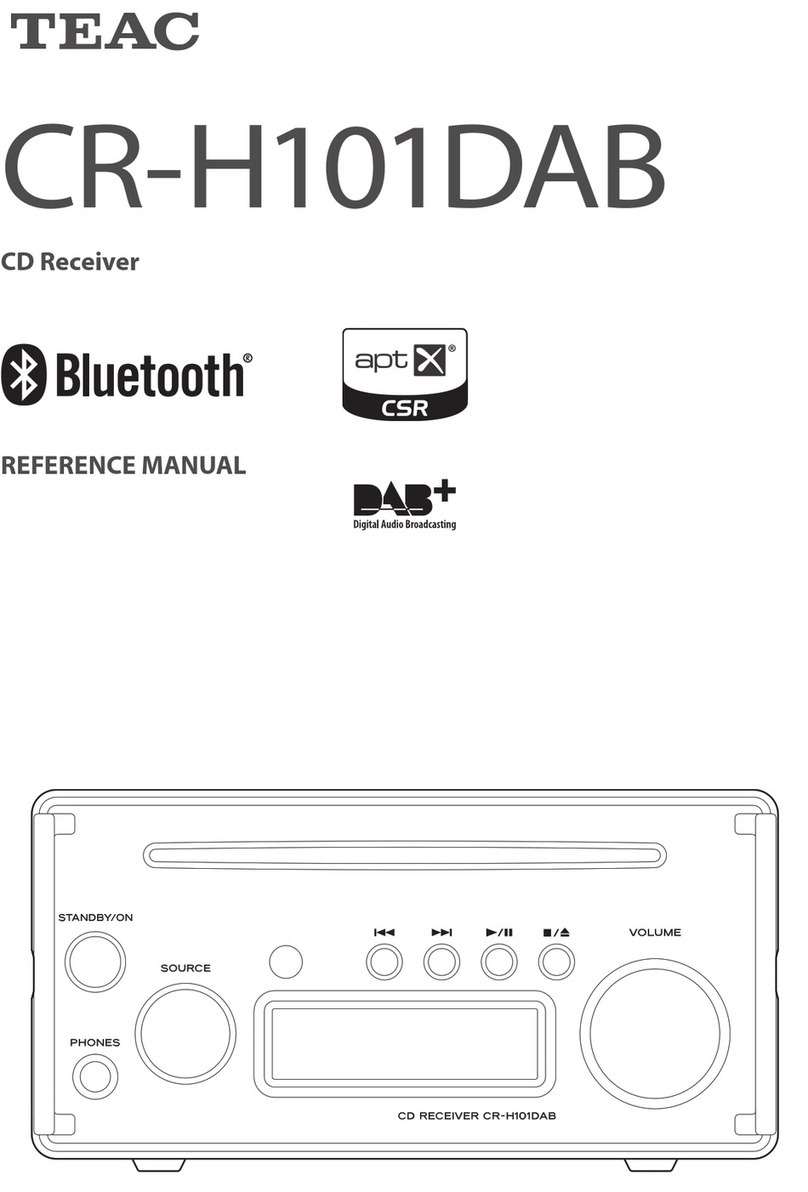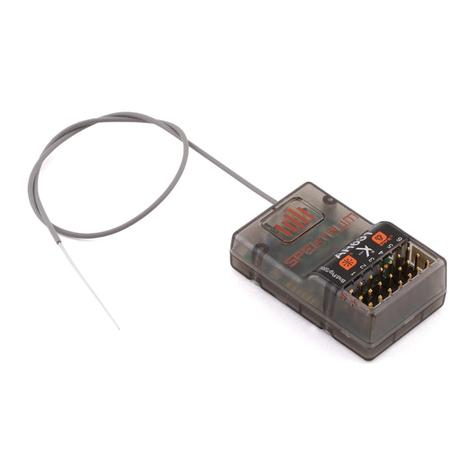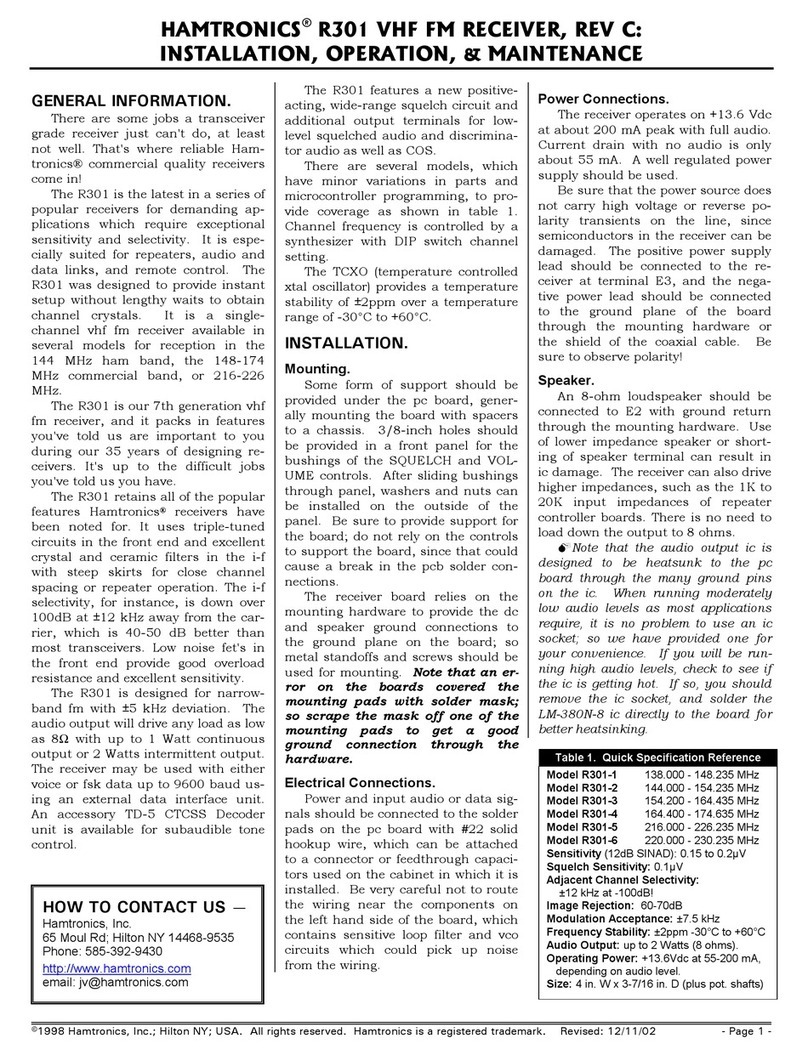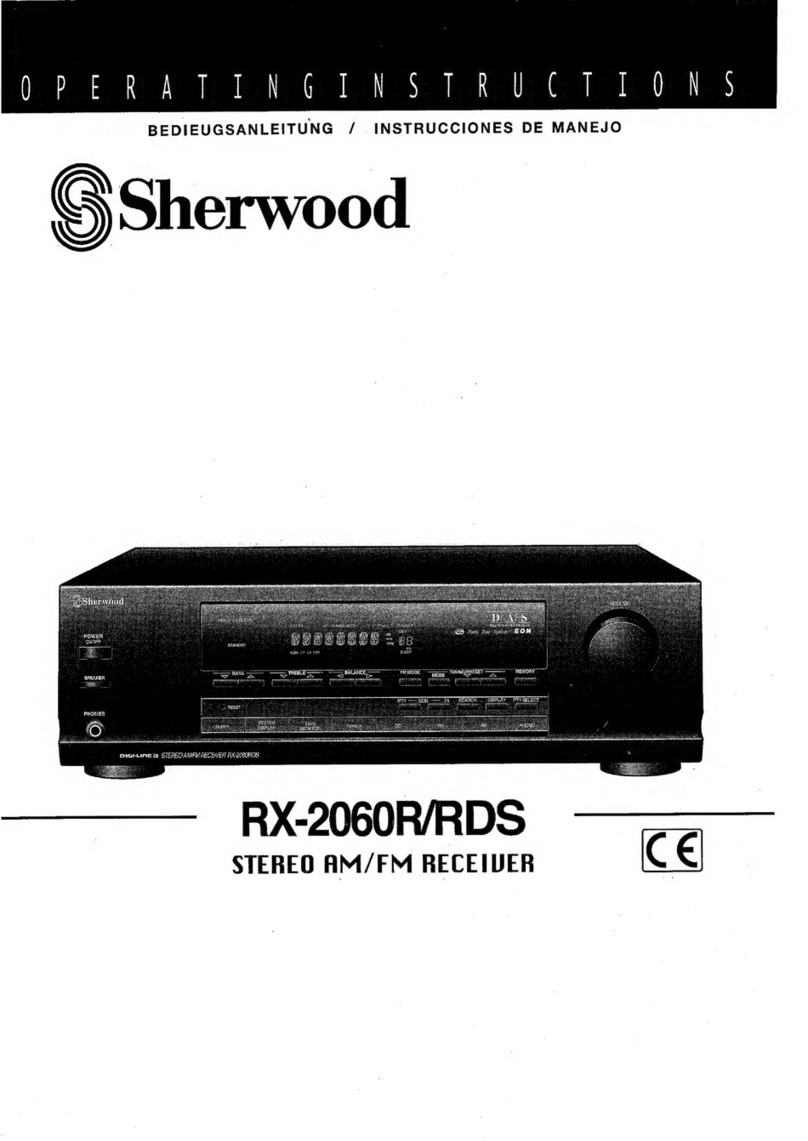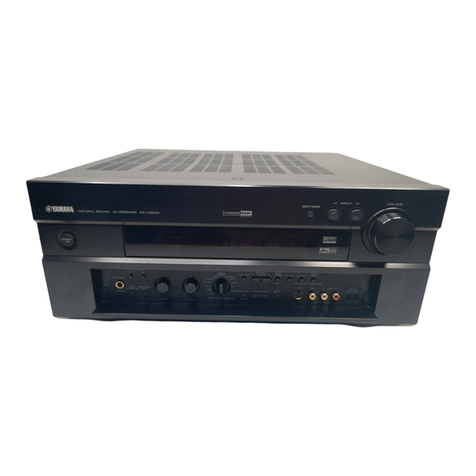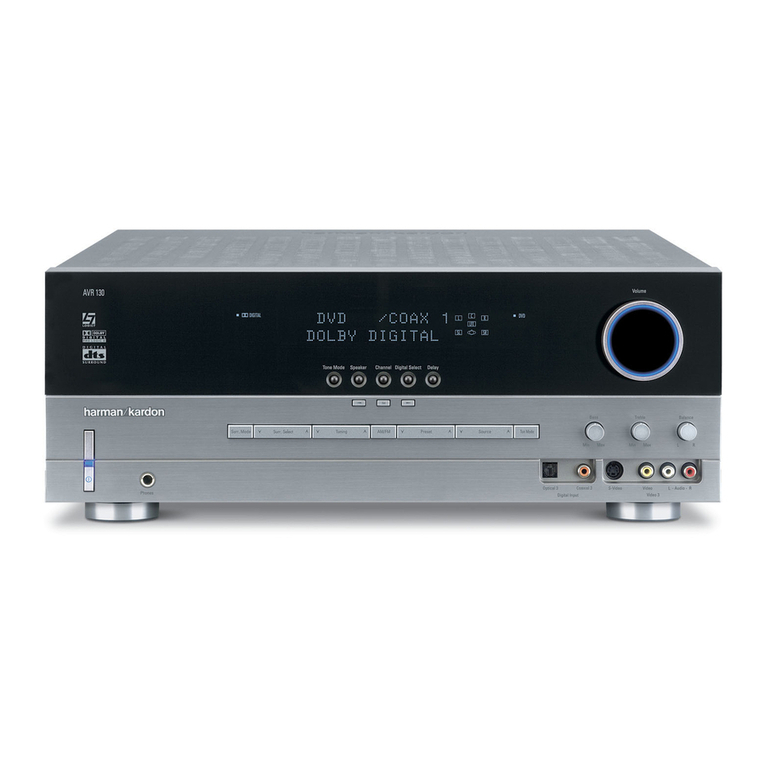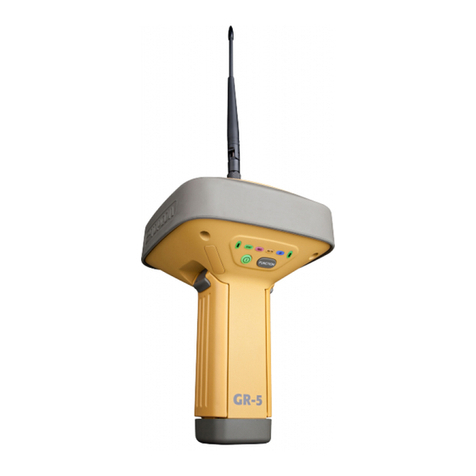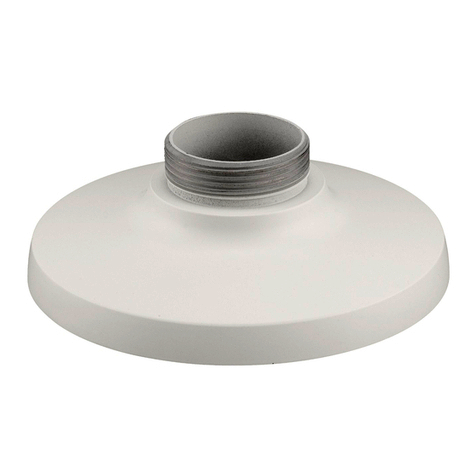B&K AVR305 User manual

B&K Components, Ltd.
AVR305
AVR307
A/V Receiver
Owner’s Manual
p/n 12858 Rev. 0717A

USER INFORMATION
B&K Components, Ltd., 2100 Old Union Road, Buffalo New York 14227-2725
p/n 12858 Rev. 0717A
SETUP CROSSOVERS + LFE
1 Crossover Hz
2 High Pass dB
3 Low Pass dB
4 Peak Limiter dB
5 LFE Level dB
6 DTS LFE Mode
7 Subwoofer Phase
next item adjust
MENU setup speakers
SETUP SPEAKER LEVELS
1 Left Front dB
2 Center dB
3 Right Front dB
4 Right Surround dB
5 Right Surr Back dB
6 Left Surr Back dB
7 Left Surround dB
8 Subwoofer dB
next item adjust
MENU setup speakers
SETUP SPEAKER SIZE
1 Front
2 Center
3 Surround
4 Surround Back
5 Subwoofer
next item adjust
MENU setup speakers
SPEAKER LOCATION feet
1 Left Front
2 Center
3 Right Front
4 Right Surround
5 Right Surr Back
6 Left Surr Back
7 Left Surround
8 Subwoofer
next item adjust
MENU setup speakers
Model #
Serial #
Date purchased
Purchased from:
City
State
Phone
Contact
SETUP ROOM EQUALIZATION
Test Tone 20 Hz Off
Notch Hz dB
Notch Width Hz
Bass Hz dB
Treble Hz dB
next item adjust
MENU setup speakers

TABLE OF CONTENTS
69
Setup Control Out 2
................................................................ 69
Setup Control Out 1
............................................................... 68
Control Outputs
....................................................................... 68
Power On Titles
....................................................................... 64
Zone 2 Setup (B)
...................................................................... 61
Zone 1 Setup (A)
...................................................................... 61
Advanced
................................................................................ 61
Advanced Features ............................................................................. 60
Getting Receiver Status
....................................................................... 59
Zone 2 Favorite Presets
....................................................................... 58
Zone 1 Favorite Presets
....................................................................... 57
Zone 2 (B)
................................................................................... 56
Zone 1 (A)
................................................................................... 55
Presets
..................................................................................... 54
Zone ‘Z’
..................................................................................... 52
Equalization ‘EQ’
............................................................................. 50
Special Considerations
.................................................................... 50
DVD Audio
............................................................................... 50
THX
.................................................................................... 50
SURROUND
............................................................................. 50
STEREO
................................................................................ 50
MONO
.................................................................................. 49
Audio Modes
................................................................................ 48
Temporary Level Adjustments
.................................................................. 48
Adjusting the Volume
......................................................................... 47
AM/FM Tuner
................................................................................ 47
Choosing a source
........................................................................... 46
Sleep
....................................................................................... 46
Power On/Off
................................................................................ 46
Operation ...................................................................................... 45
Memory Backup
.............................................................................. 43
Presets
.................................................................................. 39
Inputs
................................................................................... 36
Display
.................................................................................. 33
Room Equalization
.................................................................... 29
Crossovers + LFE
..................................................................... 28
Speaker Levels
....................................................................... 27
Speaker Location
..................................................................... 23
Speaker Size
......................................................................... 23
Speakers
................................................................................ 23
System Setup
................................................................................ 22
The Menu System
............................................................................ 22
Setup .......................................................................................... 20
Frequently Asked Questions
................................................................... 19
Control Outputs / IR Inputs
..................................................................... 19
Antenna Connections
......................................................................... 18
Speaker Outputs
............................................................................. 17
Surround Outputs
............................................................................ 16
Digital Connections
........................................................................... 14
Audio / Video connections
..................................................................... 13
Making the connection .......................................................................... 11
Rear Panel ..................................................................................... 9
Front panel ...................................................................................... 5
The Basics ...................................................................................... 4
Features ........................................................................................ 3
Safety Precautions .............................................................................. 2
Acknowledgments ...............................................................................
p/n 12858 Rev. 0717A

80
The Menu System ............................................................................... 79
Rear Panel Enlarged View ....................................................................... 78
Returning Equipment ........................................................................... 77
Receiver Specifications ......................................................................... 76
Troubleshooting ............................................................................... 75
Factory Reset
................................................................................ 73
RS-232 Control Port
................................................................... 73
DSP Usage
.......................................................................... 71
Security Options
...................................................................... 70
Setup Control Out 4
................................................................ 70
Setup Control Out 3
................................................................
1p/n 12858 Rev. 0717A

ACKNOWLEDGMENTS
Motorola® ,,“
*DigitalDNA™, “Powered by Motorola”™, Motorola name and logo are registered trademarks
of Motorola, Inc.
Manufactured under license from Dolby Laboratories. “Dolby”, ”Pro Logic”, “AC-3", and the double-D symbol are
trademarks of Dolby Laboratories. Confidential Unpublished Works. © 1992-1997 Dolby Laboratories, Inc. All
rights reserved.
Surround EX is a trademark of Dolby Laboratories. Used under authorization.
DTS® is a registered trademark of Digital Theater Systems, LLC. Additionally licensed under the following US
Patent 5,451,942 & National Patent applications derived from PCT/US95/00959. Additional U.S. and Foreign
Patents pending. “DTS”, “digital sound”, and “coherent acoustics” logos are trademarks of DTS Technology LLC.
All rights reserved.
Manufactured under license from Lucasfilm Ltd. U.S. patent numbers 5,043,970; 5,189,703; and/or 5,222,059.
European patent number 0 323 830. Other U.S. and foreign patents pending. Lucasfilm and THX are registered
trademarks of Lucasfilm Ltd. Surround EX is a trademark of Dolby Laboratories. Used under authorization.
THX, Home THX Cinema, Lucasfilm THX, Re-Equalization, Timbre Matching, Adaptive Decorrelation and THX
Ultra are registered trademarks of Lucasfilm Ltd.
The AVR305 Series II A/V Receiver with five 150 watts into 8 ohms channels of power amplification and
Lucasfilm Home THX Ultra Certification. Additionally, the AVR305 offers full THX Surround EX system
compatibility with the use of an external surround back power amplifier.
The AVR307 Series II A/V Receiver with seven 150 watts into 8 ohms channels of power amplification and
Lucasfilm Home THX Ultra Certification. Additionally, the AVR307 offers full THX Surround EX system
compatibility.
Accessories included: Owners manual, Remote control Manual, Power cord, Remote control, 4-AAA batteries
© Copyright 2000 All Rights Reserved.
B&K Components, Ltd., 2100 Old Union Road, Buffalo New York 14227-2725
2p/n 12858 Rev. 0717A

SAFETY PRECAUTIONS
PLEASE READ BEFORE INSTALLING
WARNING: to prevent fire or shock hazard, do not expose this unit to rain or moisture. Care should be taken to
prevent objects or liquid from entering the enclosure. Never handle the power cord with wet hands.
The lightning flash with arrowhead, within an equilateral triangle, is intended to alert the user of the presence of
uninsulated “dangerous voltage” within the product’s enclosure that may constitute a risk of electric shock to you.
The exclamation point within an equilateral triangle is intended to alert the user of the presence of important
operating and maintenance (servicing) instructions in the literature accompanying the unit.
Caution: To prevent the risk of electric shock, do not remove cover. No user-serviceable
parts inside. Refer
servicing to qualified service personnel.
If an outdoor antenna is connected to the antenna input, be sure it is grounded to provide some protection against
voltage surges and built up static charges. Keep the outdoor antenna away from power lines.
Unplug the receiver from the AC outlet when plugging in or unplugging cables, when left unused for an extended
period of time, moving the receiver, or when you suspect lightning in your area.
Prevent damage to the power cord. Do not bend, pull, place objects on, alter, etc. Replace the power cord if it
becomes damaged. Always grasp the plug on the power cord when plugging in or unplugging the receiver from
the AC outlet.
Your system may produce sound levels capable of causing permanent hearing loss. Do not operate for extended
periods of time at high volume levels.
Make sure the receiver is placed on a level surface.
Protect the receiver from impact. (Do not drop it!!!)
Do not climb on top of the receiver or place heavy objects on its top cover.
The receiver is equipped with raised feet to provide ventilation, reduce acoustic feedback, and provide protection
against scratching the surface the unit is resting on. We advise against removing or altering feet.
Do not stack anything on top of the receiver (processor, source, etc.) Leave a minimum of 3” clearance from the
top of the receiver to the next shelf (or component).
The receiver should be located away from heat sources such as heaters or amplifiers.
Do not perform any internal modifications to the receiver.
Always connect the receiver’s power cord to an unswitched AC outlet for normal operation.
If young children are present, adult supervision should be provided until the children are capable of following all
rules for safe operation.
Do not plug the receiver’s power cord into an outlet with an unreasonable number of other devices. Be careful if
using extension cords and ensure the total power used by all devices does not exceed the power rating
(watts/amperes) of the extension cord. Excessive loads may cause the insulation on the cord to heat and possibly
melt.
Mistaking
CONTROL OUTPUT
or IR INPUT connectors for audio/video inputs or outputs may damage your
receiver or other components.
Damage can occur to your speakers if the power rating of each individual driver is exceeded by the receiver.
Ensure that all the drivers in your system are capable of handling not only the average power being delivered by
the amplifiers, but also the peak power that is likely to be generated during strong passages.
If you are unsure of
your speaker's power rating, contact the speaker manufacturer or the dealer where you purchased them.
The receiver should be serviced by qualified personnel when:
The receiver is not functioning properly.
Objects have entered the chassis.
The receiver was exposed to rain or other type of moisture.
The receiver was dropped, or the chassis is damaged.
3p/n 12858 Rev. 0717A

FEATURES
Your new receiver is a versatile audio/video control center. The receiver is designed to sound sensational and be an
attractive, easy-to-use addition to your audio/video system. Although you already have a good idea of your receiver’s
features, we would like to take a moment to point out certain highlights.
THX Ultra Certified - incorporates Lucasfilm Home THX Re-Equalization™, Timbre Matching™ and Adaptive Decorrelation™
to correct for the tonal and spatial errors that occur during the translation from the movie theater environment into the home.
In addition to the these correction processes, the unit has passed a rigorous series of Lucasfilm THX quality and performance
tests which is your guarantee that this Home Theater product will give superb performance for years to come.
THX Surround EX - incorporates further Home THX Cinema processing to allow for the precise decoding of Dolby Digital
Surround EX signals.
Two-zone operation - complete digital/analog preamp/processor for Zone 1 (A) plus an additional independent analog A/V
preamp internally for use with a second listening/viewing area - Zone 2 (B).
Internal Digitally Synthesized AM/FM Stereo tuner - store up to 40 AM or FM stations in A/V presets.
Analog inputs/outputs - seven A/V inputs and five A/V outputs all with stereo audio, composite video and S-video plus one
set of 7.1 surround outputs.
Component Video - two switchable inputs and one set of outputs assignable to any of the seven A/V inputs. Passive design
allows full pass through of HDTV signals and maintains full signal integrity.
Digital inputs/outputs - six coaxial inputs and one coaxial output plus five optical inputs and one optical output.
Control Outputs - four 12 VDC @ 50 mA outputs for turning on amplifiers and controlling external systems such as a
projection screen or B & K amplifier.
IR inputs/outputs - two IR inputs and up to four IR outputs let you integrate the receiver with an infrared repeater control
system.
Gold Plated Connectors - better sound with minimum signal loss and degradation.
Plug and Play operation - automatically selects the optimum input, surround sound format, and performs a wide range of
automated functions to provide invisible and easy operation.
A/V presets - 40 preset memories allow instant system configuration recall of user settings.
Customized input and A/V preset names - assign names to presets, inputs, or the turn on message.
Remote Control - 8 device universal remote control, 100% pre-programmed, 100% learning, provides easy and total control
of B&K and other brand user equipment.
RS-232 Control - easy control and interface of your B&K product with other system controllers.
State-of-the-art power amplifier section -
Toroidal transformer and computer-grade electrolytic capacitors combine to provide for improved dynamics and
extended low frequency control.
Discrete Circuitry for more accurate, 3-dimensional reproduction.
Class A Predriver improves low level detail for smoother, more musical sound.
AB MOSFET Output Stage for efficient and linear power delivery.
96/24 bit A/D and D/A Conversion - Ultra High Resolution reproduction of musical details.
96/24 bit processing - 96/24 bit digital data and analog source material use 96 kHz, 24 bit DSP processing during all stereo
listening modes.
Selectable Bass Management Crossover Frequency and Slope - allows system versatility for bass adjustments and
management to assure optimum performance from your speaker system.
Room Equalization - a sweepable notch filter and variable equalization is available in the digital domain for use in achieving
the best possible room response.
Upgradable - modular design allows for future A/D, D/A, DSP, Digital Receiver, and IEEE 1394 enhancements. State of the
art today, state of the art tomorrow.
4p/n 12858 Rev. 0717A

THE BASICS
The following is intended to familiarize users with common terms and applications of Home Theater equipment.
Sources - your receiver can directly provide audio from its built-in AM/FM tuner. It can also provide limited video
from its on-screen menu system. Typically you will want to connect a number of additional sources (VCR, DVD
player, etc.) to your receiver. Your receiver is designed to accommodate a wide range of audio and video signals.
The following table lists the most popular home theater media and how the audio information is stored.
X (compressed)Mini disc (MD) X (compressed)Digital Compact Cassette (DCC) XXXXDigital Audio Tape (DAT) XXSatellite Broadcast XXXDigital Versatile Disc (DVD) XXXCompact Disc (CD) XXXXLaser disc (LD) XVideo Cassette XAudio Cassette
DTSDolby DigitalPCMAnalogSource Media
Analog vs. Digital Audio - This refers to the method used to place audio information on the source material and
how they are delivered to your receiver from the source. Analog signals exactly represent the sound you will hear
through a continuously varying voltage. Audio and video cassettes are analog recordings and are normally
delivered to your receiver over a pair of coaxial audio cables.
Digital signals closely approximate the original audio signals with a set of numbers referred to as a bitstream. CDs
and DVDs are sources of digital audio and are normally connected to your receiver through a coaxial or optical
digital cable. There are several different bitstream formats available. The simplest format is called Pulse Code
Modulation (PCM). In PCM, the bitstream directly represents the original 2-channel audio. In Dolby Digital and
DTS (see “Surround Formats” below) bitstreams are modified using a process called compression to squeeze
more information into limited space. DTS squeezes 5.1 channels into the space normally required for two
uncompressed channels, while Dolby Digital squeezes 5.1 channels into about ¼ the space required for two
channels. Your receiver automatically detects the bitstream currently being provided from the source and performs
the required decompression and surround processing. If no digital signal is present your receiver will automatically
switch to analog processing.
All sounds that you hear from your speakers are analog. Digital signals are automatically converted to analog by
your receiver before being output to your the speakers.
If analog signals exactly represent the audio, while digital signals only approximate it, why would I want to
use digital?
All analog sources add some amount of noise and distortion to the audio signal. Additional noise can be
picked up through the cables from the source to your receiver. It is impossible for the receiver to tell the
difference between the desired signal and the added noise and distortion, so it reproduces both of them.
The result is increased background noise and decreased dynamic range and fidelity. Digital signals are
virtually immune to noise and distortion. The receiver can, therefore, reproduce the signal with the
greatest possible fidelity. We recommend you use digital signals wherever possible. Also Dolby Digital and
DTS (see “Surround Formats” below) work only with digital signals.
Audio and Surround Formats - Your source material will be in one of seven possible formats described below.
Monaural (Mono) - This is the oldest format available. It contains a single, full range audio channel.
Modern recordings are seldom made in this format, but most older movies and music are available only in
this format. You may get mono from any source - digital or analog. Sound will normally come from the
5p/n 12858 Rev. 0717A

seven speaker channels, but your receiver can produce mono in one to seven channels (see “Audio
Modes under Operation”). Since all modern sources are stereo, the mono information is usually replicated
from both the left and right channels.
Stereo - Stereo contains two discrete, front left and right full range audio channels. This is the most
common format for music and is also used on many movies. You may get stereo from any source - digital
or analog. Sound will normally come from the seven speaker channels, but your receiver can produce
stereo in one (mono) to seven channels (see “Audio Modes under Operation”).
Dolby Pro Logic - Dolby Pro Logic is a refinement of Dolby Surround which was the earliest form of true
surround processing. Like Stereo, Dolby Surround contains two discrete, full range audio channels. In
addition, a monaural, limited range surround channel is encoded on the two stereo channels in a process
called matrixing. The surround channel information is encoded in positive polarity on the left channel and
in negative polarity on the right channel. The Dolby Processor can detect this encoding (left minus right)
and send that information to the surround channels. Dolby Pro Logic adds additional processing to
produce a full range center channel by extracting the mono information from the left and right channel.
This is the most common format for all but the most recent movies. Music sources are occasionally
encoded in Dolby Surround. However, many people prefer to use Pro Logic processing on all of their
stereo sources. The center channel extraction process often yields improved stereo imaging, especially
when you are sitting away from the “sweet spot” at center of the listening area. The surround channel
processing often lends a pleasing ambiance even to material that is not encoded in Dolby Surround. Dolby
Pro Logic is fully compatible with stereo and you may get it from any source - digital or analog. Sound will
normally come from all seven speakers in your system, but your receiver can produce sound in one
(mono) to seven channels (see “Audio Modes under Operation”).
Dolby Digital - Dolby Digital contains up to five discrete, full range audio channels plus an additional Low
Frequency Effects (LFE) channel. The LFE channel contains only low frequency information for enhanced
sound effects in movies. This combination of five discrete channels plus a LFE channel is often referred to
as 5.1 channels. Dolby Digital is a digital format only. It must be delivered to your receiver over a coaxial
or optical digital cable. As of the writing of this manual, Dolby Digital is commercially available on DVD and
Satellite (Also see
Dolby Digital RF
below). It is also possible to create your own Dolby Digital CDs and
DATs if you have the recording equipment. You can’t directly record Dolby Digital onto mini disc or digital
compact cassette since these devices add their own compression which is incompatible with the Dolby
Digital compression. Not all Dolby Digital recordings will include all five channels, and, in fact, it is
common on DVDs to have two channel Dolby Digital with or without Pro Logic processing. Sound will
normally come from all seven speakers in your system, but your receiver can produce sound in one
(mono) to seven channels (see “Audio Modes under Operation”).
Dolby Digital RF - Dolby Digital RF is identical to normal Dolby Digital except that it uses a special RF
encoding scheme to put the bitstream on Laser discs without replacing the normal stereo (or Dolby
Surround) PCM bitstream that is normally available from laser disc. In order to use Dolby Digital RF laser
discs you must have a B&K DT-1 RF demodulator or similar product from another manufacturer. For best
results with your receivers Plug and Play capability we recommend the B&K DT-1.
Dolby Digital Surround EX - Dolby Digital Surround EX is a new movie sound track that greatly
enhances the sense of spatial and positioning of the surround channel sound. This system was developed
jointly by Lucasfilm THX and Dolby Laboratories, using Lucas film’s idea of improving spatial expression
and achieving a 360 degree sound positioning with Dolby Laboratories’ matrix encoding technology. The
surround back channel is matrix-encoded and inserted into both Dolby Digital SL (surround left) and Dolby
Digital SR (surround right) channels. Upon playback, the signals may be decoded by a high precision
digital matrix decoder within the Dolby Digital decoder into SL, SR and SB channels.
DTS (Digital Theater Systems) - DTS is similar to Dolby Digital in that it provides 5.1 discrete audio
channels. However, it uses more digital data to encode the information and may provide greater fidelity
than Dolby Digital. DTS is a digital format only. It must be delivered to your receiver over a coaxial or
optical digital cable. No RF demodulator is required for DTS laser discs since the DTS bitstream replaces
the normal PCM bitstream. Like Dolby Digital,
6p/n 12858 Rev. 0717A

you can create your own DTS DATs or CDs but not mini disc or digital compact cassette. As with Dolby
Digital, sound will normally come from all seven speakers in your system, but your receiver can produce
sound in one (mono) to seven channels (see “Audio Modes under Operation”).
DVD Audio (also referred to as MLP) - Meridian Lossless Packing (MLP) is a lossless coding system for
high-quality linear PCM audio. For DVD-Audio MLP performs lossless compression of up to 6 channels of
up to 24-bit material sampled at rates between 44.1kHz and 192kHz. Lossless coding does not alter the
final signal, it ‘packs’ the audio data into a smaller rate and space. Currently, DVD Audio can only be
delivered to your receiver via the analog 5.1 input. Sound will normally come from all seven speakers in
your system, but your receiver can produce sound in one (mono) to seven channels (see “Audio Modes
under Operation”).
Home THX Cinema Processing - THX is an exclusive set of standards and technologies established by
the world-renowned film production company, Lucasfilm Ltd. THX grew from George Lucas’ personal
desire to make your experience of the film soundtrack, in both movie and in your home theater, as faithful
as possible to whatever the director intended.
Movie soundtracks are mixed in special movie theaters called dubbing stages and are designed to be
played back in movie theaters using similar equipment and conditions. The soundtrack created for movie
theaters is then directly put onto reproducible media, DVD, VHS tape Laser disc, etc... With no changes to
account for playback in a smaller home theater environment.
THX engineers developed patented technologies to accurately translate the sound from the movie theater
environment into the home, correcting for the tonal and spatial errors that occur. While Home THX
Cinema mode is active, THX processing is added after the Dolby Pro Logic, Dolby Digital or DTS decoder.
Sound will normally come from all seven speakers in your system, but your receiver can produce sound in
one (mono) to seven channels (see “Audio Modes under Operation”).
Re-Equalization™ - restores the correct tonal balance for watching a movie soundtrack in a small home
theater.
Timbre Matching™ - filters the information going to the surround speakers so that they more closely
match the tonal characteristics of the sound coming from the front speakers. This ensures seamless
panning from the front to surround speakers.
Adaptive Decorrelation™ - slightly changes one surround channel’s time and phase relationship with
respect to the other surround channel. This expands the listening position and creates a more spatial
sense using only two speakers.
THX Surround EX – Dolby Digital Surround EX is a joint development of Dolby Laboratories and the THX
division of Lucasfilm Ltd.
In a movie theater, film soundtracks that have been encoded with Dolby Digital Surround EX technology
are able to reproduce an extra channel which has been added during the mixing of the program. This
channel, called Surround Back, places sounds behind the listener in addition to the currently available
front left, front center, front right, surround right, surround left and subwoofer channels. This additional
channel provides the opportunity for more detailed imaging behind the listener and brings more depth,
spacious ambiance and sound localization than ever before.
When released to the home consumer market, movies that were created using the Dolby Digital Surround
EX technology, may have a note to that effect on the packaging. A list of movies created using this
technology can be found on the Dolby web site at http://www.dolby.com.
Only receiver and controller products bearing the THX Surround EX logo, when in the THX Surround EX
mode, faithfully reproduce this new technology in the home.
This product may also engage the “THX Surround EX” mode during the playback of 5.1 channel material
that is
not
Dolby Digital Surround EX encoded. In such case the information delivered to the Surround
Back channel will be program dependent and may or may not be very pleasing depending on the
particular soundtrack and the tastes of the individual listener.
7p/n 12858 Rev. 0717A

Bass Management - Dolby Digital and DTS formats contain up to 5 full range channels plus LFE. Only a system
with five full-range (large) speakers plus a subwoofer can directly reproduce these formats. However, almost all
commercially available center channel speakers are small and incapable of reproducing the lowest bass
frequencies without distortion or even damage to the speaker. Many people also use small speakers in the rear of
their system, while others use small speakers all around. Use of a subwoofer is almost mandatory when using five
small speakers, but people with at least two large speakers may or may not choose to use a subwoofer. Some
people may not use a center channel or surround speakers at all. In order to handle any possible combination of
large, small, or missing speakers, a home theater system must contain good bass management, a concept often
missing from two-piece systems where the Dolby Digital or DTS decoder is separate from the preamp. Your
receiver contains a complete bass management system. You can use as few as two large front left and right
speakers or two small left and right speakers plus a subwoofer or as many as seven full range speakers plus a
subwoofer or any combination in between without missing any information. Wherever small speakers are used the
bass management system prevents low bass information from going to that speaker (“high pass”). This bass
information is rerouted to a speaker that can handle it, usually a subwoofer, but it can also send center, surround,
or LFE bass to large front speakers if no subwoofer is available. When center or surround speakers are not used
at all, the missing channel is sent (“down mixed”) to the front speakers.
Preamp - A preamp typically includes the capability to select from a number of sources, adjust volume levels and
route the data to an amplifier. Your receiver includes a high quality preamp.
Processor - A processor typically includes the capability to decode one or more surround formats, and convert
between digital and analog as required. Your A/V system controller includes a high quality processor capable of
decoding the surround formats described above.
Zone - A zone is usually a room that has speakers installed in it. Your receiver includes a full preamp/processor
for Zone 1 (A) plus an additional analog stereo preamp for Zone 2 (B). This allows, for example, watching a Dolby
Digital movie in zone one while simultaneously using the built-in AM/FM tuner in another room.
Amplifier - An amplifier takes the output of a preamp/processor and increases its level to that necessary to drive a
speaker.
Speakers - A surround sound system use to typically use 5 speakers located left front, center front, right front,
right surround, and left surround plus a subwoofer located anywhere in the room. With the new developments in
surround technology from companies such as Dolby Laboratories, DTS, and Lucasfilm, it is now possible to
improve spatial expressions with an additional channel of information for use with a 6th and/or 7th surround back
speaker. Although best results are achieved using seven large speakers plus a subwoofer, this is not always
practical. Excellent results can be achieved using small and/or fewer speakers, as long as you go through the set
up procedures described later in the manual. Your receiver includes the capability of reproducing up to 6.1
channels of surround information.
Component video vs. S-video vs. Composite video - Composite video is the oldest standard for color video. It
combines the luminance (brightness or black-and-white) and chrominance (color) information onto a single
conductor. These signals must be separated again for display resulting in some degradation of the video quality.
S-video is a newer standard that uses separate conductors for the luminance (Y) and chrominance (C) information
resulting in better video quality. Component video is the newest form of video introduced with DVD. This video
format uses separate conductors for luminance (Y), red - luminance (R - Y), and blue - luminance (B - Y). Using
these signals a component video capable monitor allows for even better and higher resolution video quality. Your
receiver is capable of switching composite, S-video and component signals, but it cannot convert between video
types. In addition, your receiver is capable of switching between two pairs of component video inputs.
8p/n 12858 Rev. 0717A

FRONT PANEL
1. Headphone Jack - Stereo headphones having a standard ¼ inch binaural plug can be connected to the
headphone output. The receiver must be on and in HEADPHONE Mode for proper headphone operation.
2. Front panel buttons
SLEEP
PRESET
ENTER
SAVE
DOWN UP
SOURCE
MODE
MENU
Puts the receiver in standby (low power) mode.
Steps through audio / video presets for instant recall of setups.
Pressing ENTER recalls the preset.
Confirm selection or display current status of the receiver.
Pressing SAVE followed by ENTER saves a favorite preset.
Step through menus, sources, or audio modes.
Steps through the audio / video sources.
Steps through the audio modes.
Enter / exit menu system
3. Main power switch - Removes all power to the receiver. Normal operation of the receiver requires the power
switch to remain on. Use the Sleep button for daily on and off of the receiver. It places the unit in standby mode
that allows turning back on with the remote control. Turn the receiver off with the main power switch when not
using the receiver for an extended period of time.
4. Volume control - For controlling system volume. Turning the encoder-type volume control clockwise increases
the volume level, counterclockwise decreases the volume level. The volume knob is also used to change other
receiver settings. See THE MENU SYSTEM and OPERATION
9p/n 12858 Rev. 0717A

5. Status indicators - Displays current status of the receivers audio processor. Indicators have been supplied to
show when the DSP is decoding Dolby Digital ‘
Digital’, Dolby Pro Logic ‘
Pro Logic’, or DTS audio. There is
an indicator to show the input to the S/PDIF digital receiver is 96kHz 24 bit data ‘96/24’ or an analog input that is
being sampled using 96kHz/24bits. Finally, there is an indicator to show processed audio is sourced from the
selected analog input ‘Analog’. See MODE OPERATION
6. Display - The receiver display is a 16 character alphanumeric fluorescent display. Displays current status of
receiver and any changes being performed.
10 p/n 12858 Rev. 0717A

REAR PANEL
The receiver’s back panel is organized into groups of inputs and outputs for audio and video as shown below. See
back of this manual for an enlarged view.
1. AC fuse holder - Holds the AC Line fuse. Replace only with same type and value.
2. AC input receptacle - For attaching the supplied AC power cord to the receiver.
3. IEEE 1394 input (optional) -For future interface applications.
4. Control outs - Outputs that allow you to remotely control external devices. (See “Making The Connection“).
5. IR in - Accepts input from external IR receptors. Connect an IR repeater (“home run”) to IR IN for controlling the
receiver. This method of control is useful when the front IR receptor is blocked (for example, by a cabinet door) or
to control the receiver from another room. This input is typically used in place of an emitter attached to the front
panel.
6. RS-232 input -Computer interface applications.
7. Speaker outputs - Connections for your speakers.
Red binding posts
- speakers (+)
Black binding posts
- speakers (-)
8. DVD Audio inputs - Connections for a DVD audio or other 5.1 source device.
Red RCA jacks
- right front and surround audio inputs
White RCA jacks
- left front and surround audio inputs
Gray RCA jacks
- center and sub audio inputs
9. Surround outputs - Variable level outputs for driving external power amplifiers or powered speakers.
10. Antenna inputs - Connections for the AM and FM antennas.
11 p/n 12858 Rev. 0717A

11. Component Video outputs - Switched output connections for your component video monitor.
Red RCA jack
- typically connect to the red input on a component video monitor
Green RCA jack
- typically connect to the green input on a component video monitor
Blue RCA jack
- typically connect to the blue input on a component video monitor
12. Component Video inputs - Switched input connections for two component video devices.
Red RCA jack
- typically connect to the red output of a component video source
Green RCA jack
- typically connect to the green output of a component video source
Blue RCA jack
- typically connect to the blue output of a component video source
13. Line inputs - Connections from your audio/video sources.
Red RCA jacks
- right analog audio
White RCA jacks
- left analog audio
Yellow RCA jacks
- composite video
4 pin din jacks
- S-video
14. Line level outputs - Fixed level outputs to an audio or video recorder.
15. Zone 2 (B) outputs - Variable level outputs to your video monitors and external amplifiers.
16. Zone 1 (A) outputs - Variable level outputs to your video monitors.
17. Optical Digital inputs - Optical digital inputs are used to connect digital audio signals from your source to the
receiver. The incoming signal may be PCM, Dolby Digital or DTS.
18. Optical Digital output - Zone 1 (A) optical output to carry digital information from the selected digital input of
the receiver out to digital recorders, personal computers, etc.
19. Coax Digital inputs - Coax digital inputs are used to connect digital audio signals from your source to the
receiver. The incoming signal may be PCM, Dolby Digital (AC-3) or DTS.
20. Coax Digital output - Independent Zone 1 (A), and Zone 2 (B), coax outputs to carry digital information from
the selected digital input of the receiver out to digital recorders, personal computers, etc.
21. AC Line Voltage -Indicates the proper voltage and frequency needed to operate your receiver.
Serial number -The serial number of your unit is located on bottom of unit.
12 p/n 12858 Rev. 0717A

MAKING THE CONNECTION
It’s tempting to just plug in your new A/V receiver and have great sound pour out. Before you do that, take a few
minutes to plan out how you want the receiver to fit into your audio/video system. Ask yourself the following
questions:
y
What source components do I want to connect to my receiver? (CD, VCR, etc.)
y
What equipment will be receiving the audio and video? (TV monitor, Speakers, etc.)
The answers to your questions determine how many cables you need to connect to the back of the receiver. Good
preplanning equals great sound. Keep these recommendations in mind:
y
List all components in your system and indicate which jacks of the receiver each component will be connected
to. Your receiver has seven sets of inputs. It is convenient to connect a DVD player to the input labeled DVD
or a VCR to the input labeled V1 or TAPE, etc. However, your equipment may differ from the labeling on the
back of your receiver. In most cases you can connect any type of source to any input (see FREQUENTLY
ASKED QUESTIONS). For example, if you don’t have a satellite receiver you can connect a DAT player or a
second cassette deck to SAT. You can also reprogram the source name that will appear on your receiver’s
front panel and on-screen display (see SYSTEM SETUP - INPUTS)
y
Also note the length of the cable for each component’s connection and describe how it should be routed or
draw your routing scheme below your list. You may want to label each cable with a name or number at both
ends. Use high quality connections to maintain high quality audio and video.
y
Think about the type and length of cable you need and obstacles in the cable’s path (doorways, furniture,
walkways, etc.). To decide which ones are right for you talk to your dealer about the various cable products
that are available.
y
For safety, keep all cables out of high traffic areas (hallways or doorways) and away from equipment that
radiates power, including amplifiers, power cords, heaters, etc.
y
If you might expand your audio/video system later, keep these ideas in mind as you plan current cable runs.
y
To provide the best tuner reception, make sure the antenna is at least several feet away from the receiver and
any other equipment that may produce high frequency interference such as Personal computers, CD players,
halogen lamps, etc.
Take a look at the back panel of the receiver. You will notice that the RCA-type audio input and output connectors
are identified by colors, red for right channel and white for the left channel audio. Component video input and
output connectors are identified by Red/Green/Blue. Composite video input and output connectors are identified by
yellow. Coaxial digital inputs are identified by orange. The surround outputs are identified by Red/White/Grey.
13 p/n 12858 Rev. 0717A

AUDIO / VIDEO CONNECTIONS
Connecting your analog sources to your receiver
Audio / Video source - connecting a DVD/VLD player to the receiver’s analog inputs. Use the same instructions
for connecting to other audio / video sources such as a television, satellite receiver, cable box, etc. See
Connecting Video for use with other than composite and S-video (Omit the video connections for an audio-only
component such as a CD player)
Attach one end of the audio interconnect cable to the left audio
output on the DVD/VLD player, then attach the other end to the
left (white) DVD/VLD audio input on the receiver. Repeat for the
right (red) audio connection. Attach one end of the composite
video interconnect cable to the video out on the DVD/VLD
player, then attach the other end to the yellow video input on the
receiver labeled DVD/VLD. Repeat for the S-video connections
if you are using S-video.
Video Monitor - Attach one end of the composite video
interconnect cable to the video input on the monitor, then attach
the other end to the yellow video output on the receiver’s ZONE
OUTPUTS. Repeat for the S-video connections if you are using
S-video. Dual zone operation requires connections be made to
(ZA) for Zone 1, and (ZB) for Zone 2.
VCR or audio recorder - connect a VCR to V1 . Use the same
instructions for connecting to the V2 and TAPE analog inputs. If
connecting a cassette deck or other audio-only recorder then omit the video connections.
LINE INPUTS
Left audio input
from VCR output
Composite video input
from VCR output
S-Video input
from VCR output
V1
Right audio input
from VCR output
LINE OUTPUTS
Left audio output
to VCR input
Composite video output
to VCR input
S-Video output
to VCR input
V1
Right audio output
to VCR input
Attach one end of the audio interconnect cable to the left audio output on the VCR, then attach the other end to the
left (white) V1 audio input on the receiver. Repeat for the right (red) audio connection. Attach one end of the
composite video interconnect cable to the composite video output on the VCR, then attach the other end to the
yellow video input on the receiver labeled V1. Repeat for the S-video connections if you are using S-video.
Attach one end of the audio interconnect cable to the left audio input on the VCR, then attach the other end to the
left (white) V1 audio output on the receiver. Repeat for the right (red) audio connection. Attach one end of the
composite video interconnect cable to the composite video input on the VCR, then attach the other end to the
yellow video output on the receiver labeled V1. Repeat for the S-video connections if you are using S-video.
14 p/n 12858 Rev. 0717A
LINE INPUTS
Left audio input from
DVD output
Composite video input
from DVD output
S-Video input
from DVD output
DVD
Right audio input from
DVD output
S BACK
Composite video output
to monitor input
S-Video output
to monitor input
ZA

Component Video - in addition to S-video and composite video switching, your receiver provides two sets of
component video inputs for DVD and TV/DBS type inputs, and one set of component video outputs. Your
receivers component video connection are passive to minimize the possibility of video format compatibility issues.
Use the same instructions to connect a second (TV/DBS) component video device.
IN 1
Component video input to DVD
red output
Component video input to DVD
g
reen output
Component video input to DVD
blue output
IN 2
Component video input to V1
red output
Component video input to V1
g
reen output
Component video input to V1
blue output
COMPONENT VIDEO
OUT
Component video output to the
video monitor's red input
Component video output to the
video monitor's
g
reen input
Component video output to the
video monitor's blue input
Attach one end of a video interconnect cable to the red video output on the DVD, then attach the other end to the
red component video input (IN 1) connector on the receiver. Repeat for (green) and (blue) video connections.
Repeat for the other (TV/DBS) component source device using component video input (IN 2). Attach one end of a
video interconnect cable to the red component video output (OUT) on the receiver, then attach the other end to the
red video input on the video monitor. Repeat for (green) and (blue) video connections.
DVD Audio - connect a DVD Audio or other 5.1 surround format device, to the receiver’s DVD Audio input.
Connect to the DVD audio
player Subwoofer output
Connect to the DVD audio
player Left Surround output
Connect to the DVD audio
player Ri
g
ht Surround output
DVD AUDIO IN
SURR
Connect to the DVD audio
player Center output
Connect to the DVD audio
player Left Front output
Connect to the DVD audio
player Ri
g
ht Front output
FRONT
SUB CENTER
Attach one end of an audio interconnect cable to the center output on the DVD Audio source device, then attach
the other end to the FRONT center (gray) DVD Audio input on the receiver. Repeat for the front left (white) and
front right (red) audio connection. Attach one end of an audio interconnect cable to the sub output on the DVD
Audio source device, then attach the other end to the SURR subwoofer (gray) DVD Audio input on the receiver.
Repeat for the surround left (white) and surround right (red) audio connection.
15 p/n 12858 Rev. 0717A

DIGITAL CONNECTIONS
Connect digital inputs (DVD, VLD, etc.) to the receiver. You will need either coaxial or optical digital inputs to play
Dolby Digital (AC-3) or DTS surround sound
processing. Digital connections are also
recommended for PCM sources. If your source has
both optical and coaxial outputs connect only one.
Coaxial digital inputs - standard RCA type
connectors. Attach one end of your digital coaxial
cable to your source coaxial digital out and the other
end to the appropriate receiver coaxial digital (orange)
input.
Optical digital inputs - First, remove the cap on
the optical digital input. Save the cap. Attach one
end of your digital optical cable to your source and
the other end to the appropriate digital input on the
back of the receiver.
Connecting A Laser disc Player - Dolby Digital
(AC-3) laser discs use a special technique called
AC-3 RF to encode the Dolby Digital bitstream. If the
laser disc player is capable of playing back Dolby
Digital discs it will have a separate output for this
bitstream in addition to the normal coaxial and/or
optical outputs. Do not connect the AC3-RF output
directly to your receiver. The AC-3 RF bitstream must
first be converted to a normal (non-RF) Dolby Digital
type signal. It is recommended that a B&K DT-1 be
used to convert and select between the Laser’s AC-3
RF and PCM/DTS signals. The output from a DT-1
will automatically select between the connected
PCM/DTS bitstreams and the converted AC-3 RF
Dolby Digital signal. Other AC-3 RF to Dolby Digital
decoders may not make this switch automatically.
Connect the laser disc’s AC3-RF output to the DT-1’s AC-3 RF input. Connect either the laser disc player’s PCM
coaxial or optical digital output (not both) to the DT-1’s coaxial or optical input. Connect the DT-1’s coaxial output
to the desired coaxial digital input on your receiver.
Digital Outputs - Separate
and independent coax
digital outputs are available
for Zone 1 (A) and Zone 2
(B). Connect to a digital
recorder (CD-R, mini disc,
DAT, personal computer,
etc.) These signals are the
same as the incoming
digital signal from the
selected source on each
zone. If your digital
recorder has both optical
and coaxial inputs you
need only connect one.
Zone 1 (A) selected digital
input is converted to both
coaxial and optical. You
may connect one digital recorder to the optical output and another recorder to the coaxial. Zone 2 (B) digital output
is coax.
16 p/n 12858 Rev. 0717A
Coax digital input
from DVD output
SAT DVDCD
TV V2 V1
COAX DIGITAL
ZB OUT
ZA OUT
V2DVDCDSAT OPTICAL DIGITAL
Optical digital output
from source
V1
Coax digital input
from VLD output
SAT DVDCD
TV V2 V1
COAX DIGITAL
MAIN
OUTPUT AC-3 RF
INPUT
COAX
INPUT
AC-3 RF input
from VLD output
DT-1
Zone 1 (A) Optical di
g
ital output
to di
g
ital recorder
V2DVDCDSATOPTICAL DIGITAL
OUT V1
SAT DVDCD
TV V2 V1
COAX DIGITAL
ZB OUT
ZA OUT
Zone 1 (A) Coax di
g
ital output
to di
g
ital recorder
Zone 2 (B) Coax di
g
ital output
to di
g
ital recorder

SURROUND OUTPUTS
Your receiver has multiple surround processor outputs for use with external amplifier(s) or powered speakers. The
AVR 305 receiver allows THX Surround EX compatibility via it’s two Surround Back ‘S BACK’ processor outputs.
Here is a typical surround output setup:
Connect to the Subwoofer 'SW'
power amplifier input
Connect to the Surround Left
'Sl' power amplifier input
Connect to the Surround Right
'Sr' power amplifier input
ZA AUDIO OUT
SURR
Connect to the Center power
amplifier input
Connect to the Left Front
power amplifier input
Connect to the Right Front
power amplifier input
FRONT
SUB CENTER
Connect to Zone 1 (A)
composite video monitor input
Connect to the Surround Back Left
'Sbl' power amplifier input
Connect to the Surround Back Right
'Sbr' power amplifier input S BACK
Subwoofer Output - Connect an RCA cable from the receiver’s SW output (part of the surround outputs). If your
subwoofer does not contain its own amplifier you will need to purchase an external B&K or other power amplifier.
Connect the receiver’s SW output to the audio input of the external amplifier. Connect the external amplifier’s
speaker output to your subwoofer.
17 p/n 12858 Rev. 0717A
This manual suits for next models
1
Table of contents
Other B&K Receiver manuals
